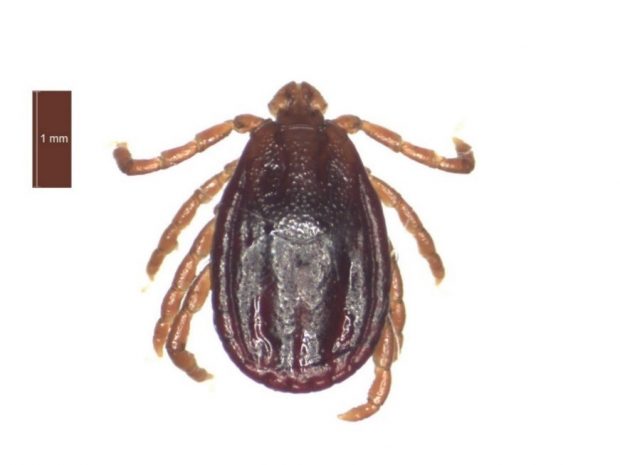As blood feeders, ticks are very efficient disease vectors. Indeed worldwide, tick-borne diseases may be the greatest threat to farm animal production as well as the second greatest threat to human health, second only to mosquito-borne diseases. Both groups are being actively studied at APHA. In this blog, Paul Phipps from the Virology Department discusses ticks and the diseases associated with the red sheep tick.

Disease vectors
Several diseases of veterinary public health interest are so-called vector-borne diseases. A disease vector is an agent that carries and transmits an infectious pathogen (including viruses, bacteria, protozoa and helminths) into another living organism such as midges, ticks and mosquitos. For example, diseases of livestock like bluetongue and Schmallenberg can be transmitted by midges.
In recent years, the range of one of the most common tick species in the country, the red sheep tick, has increased across the southern counties of England. This was recently reported in a scientific article, entitled ‘Has the Red Sheep Tick, Haemaphysalis Punctata, Recently Expanded its Range in England?’ that arose from research carried out by APHA and Public Health England (PHE).
Ticks and their lifecycle
Ticks are arachnids (not insects) related to spiders and mites and are parasites of mammals, birds, reptiles and in some cases amphibians. Hard tick species, one of the two main tick families, are characterised by having a hard shell-like protective covering across their backs.
Ticks have three separate feeding stages: larva, nymph and finally adult male or female, with each stage requiring a separate blood meal to complete the life cycle. For many species of ticks, each of three feeding/developmental stages will require a specific animal host.
An adult female hard tick may lay up to 5,000 eggs which allows for losses at each feeding stage due to the fickle hand of fate when they drop off their host in a suitable habitat for metamorphosis… or not! Some tick species feed specifically on one class of animal whilst others have less discriminatory tastes such as the castor bean tick, Ixodes ricinus, which will happily feed on birds, reptiles or mammals during its life cycle.
Tick surveillance in the UK
For a number of years, APHA has been working closely with PHE to document the range and abundance of indigenous ticks and monitor for the introduction of exotic species such as the brown dog tick, Rhipicephalus sanguineus which is a vector for canine babesiosis, a red blood cell destroying disease. This has partly been through their Tick Surveillance Scheme. This collaboration resulted in the detection of an outbreak of canine babesiosis in Essex for the first time in the UK and the discovery of an exotic tick Hyalomma rufipes on an untraveled horse in Dorset, this tick species being a potential vector of Crimean Congo haemorrhagic fever virus. You may be interested in reading the report from PHE .
In recent years, PHE has received multiple reports and tick specimens infesting humans and dogs from The South Downs National Park. These submissions were dominated by the red sheep tick, Haemaphysalis punctata. PHE and APHA have since surveyed various sites where these reports originated from and have caught all life stages of the tick from each site visited.

PHE have detected a spotted fever group Rickettsia species (R. massiliae) from H. punctata ticks and APHA have detected Babesia and Theileria species, parasites of livestock, using molecular assays developed at our Weybridge headquarters. R. massiliae may cause the human disease Mediterranean Spotted Fever with symptoms of high fever, severe headache and joint pain, maculopapular rash and reduced liver function. Babesia and Theileria species of cattle and sheep are related to the human malaria parasite. Babesia sp infect red blood cells of their host and Theileria sp infect both lymphocytes and red blood cells causing fever, anaemia and both may be fatal in some cases. In 2005, investigations led by David Welchman of APHA Winchester were carried out on a disease outbreak in sheep grazing the North Kent marshes associated with very heavy infestations of H. punctata ticks. From a group of 60 ewes and their lambs more than 25 ewes had died with post mortem clinical signs of severe anaemia and oedema of the face, mouth and lungs. Microscopic examination of blood smears revealed parasites within red blood cells which were later identified as Theileria luwenshuni using molecular techniques developed at Weybridge.
Spread of the Red Sheep Tick
Does this represent expansion of the geographical range of H. punctata in the South of England and if so, what is driving this? The evidence so far is that yes, the species is expanding its range and this trend is set to continue. Perhaps movement of livestock to selectively graze the chalky South Downs habitat and the relatively mild winters we experience have enabled this to happen.
In light of climate change and the possibility of incursion and establishment of both exotic vectors and the pathogens they carry, it is more important than ever that we understand what our disease vectors are doing. Both APHA and PHE vector borne disease specialists are committed to working together, sharing our accumulated knowledge and collaborating to publish our findings in the scientific press.
Enjoyed reading? Then why not subscribe to the APHA Science Blog

Recent Comments